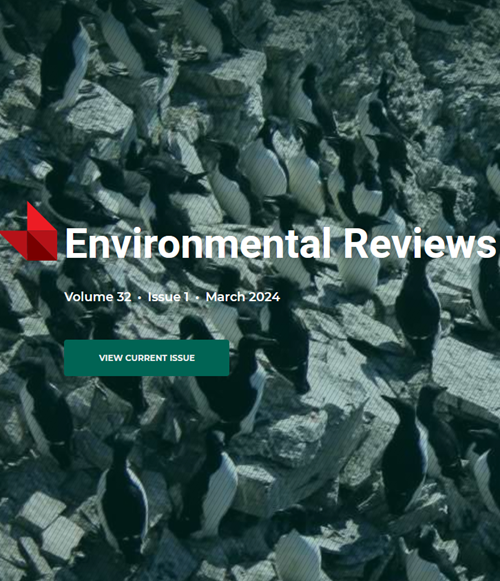Historical, contemporary, and future perspectives on a coupled social-ecological system in a changing world: Canada’s historic Rideau Canal
IF 5.1
3区 环境科学与生态学
Q2 ENVIRONMENTAL SCIENCES
引用次数: 8
Abstract
Anthropogenic waterways and canal systems have been part of the cultural and natural landscape for thousands for years. As of the late 20th century, more than 63,000-km of canals exist worldwide as transport routes for navigation, many with barriers (e.g., locks, dams) that fragment the system and decrease connectivity. Fragmentation alone can have negative implications for freshwater biodiversity; by isolating populations and communities, other human-mediated disturbances associated with canals like poor water quality and invasive species can exacerbate these negative effects. As such, the capacity of these interconnected freshwater systems to support biodiversity is continuously degrading at a global level. One critical, highly complex issue that unites canals worldwide is the challenge of governing these systems in a holistic, unified way to both protect biodiversity and preserve historical elements. Managing historic canals involves multiple objectives across many agencies and stakeholders, often with different or conflicting objectives. Here, we use the Rideau Canal, a UNESCO World Heritage Site and National Historic Site of Canada, as a case study to demonstrate the importance of considering canals as social-ecological systems for effective and efficient governance. Historic canals are integrated systems of both humans (social) and the environment (ecological), linked by mutual feedbacks and coevolution, and must be managed as such to achieve conservation goals while maintaining commemorative integrity. We discuss the history of the Rideau Canal and its current governance, biodiversity in the waterway, different threats and issues (user conflicts, aquatic pollution, shoreline development, water management, species at risk, and invasive species), and conclude by outlining ways to address the challenges of managing it as a coupled social-ecological system. We present different research needs and opportunities that would enable better management, though above all, we propose a shift from the current governance structure – which at best can be considered “patchwork” – to a coordinated, multi-scalar and multi-stakeholder governance regime such that the Rideau Canal can be maintained for its historical integrity without compromising biodiversity conservation. Given that canals are now pervasive worldwide, this article is not only topical to the Rideau Canal, but also to other waterways in Canada and beyond.从历史、当代和未来的角度看不断变化的世界中耦合的社会生态系统:加拿大历史上的里多运河
几千年来,人为的水道和运河系统一直是文化和自然景观的一部分。截至20世纪末,全球有超过63,000公里的运河作为航运运输路线,许多运河都有障碍(如船闸、水坝),这些障碍使运河系统支离破碎,降低了连通性。破碎化本身就可能对淡水生物多样性产生负面影响;通过隔离人口和社区,其他与运河相关的人为干扰,如水质差和入侵物种,会加剧这些负面影响。因此,这些相互关联的淡水系统支持生物多样性的能力在全球范围内不断退化。将世界各地的运河联系在一起的一个关键、高度复杂的问题是,如何以整体、统一的方式管理这些系统,既要保护生物多样性,又要保留历史元素。管理历史运河涉及许多机构和利益相关者的多个目标,往往具有不同或相互冲突的目标。在这里,我们以被联合国教科文组织列为世界遗产和加拿大国家历史遗址的里多运河为例,展示了将运河视为有效治理的社会生态系统的重要性。历史运河是人类(社会)和环境(生态)的综合系统,通过相互反馈和共同进化联系在一起,必须这样管理,以实现保护目标,同时保持纪念的完整性。我们讨论了里多运河的历史及其目前的治理、水道的生物多样性、不同的威胁和问题(用户冲突、水生污染、海岸线开发、水资源管理、濒危物种和入侵物种),并概述了如何应对将其作为一个耦合的社会生态系统进行管理的挑战。我们提出了不同的研究需求和机会,可以实现更好的管理,尽管最重要的是,我们建议从目前的治理结构(最多可以被认为是“拼凑”)转变为一个协调的、多尺度的、多利益相关者的治理机制,这样里多运河就可以在不损害生物多样性保护的情况下保持其历史完整性。鉴于运河现在遍布世界各地,这篇文章不仅是关于里多运河的,而且还涉及加拿大和其他地区的其他水道。
本文章由计算机程序翻译,如有差异,请以英文原文为准。
求助全文
约1分钟内获得全文
求助全文
来源期刊

Environmental Reviews
环境科学-环境科学
自引率
3.50%
发文量
45
期刊介绍:
Published since 1993, Environmental Reviews is a quarterly journal that presents authoritative literature reviews on a wide range of environmental science and associated environmental studies topics, with emphasis on the effects on and response of both natural and manmade ecosystems to anthropogenic stress. The authorship and scope are international, with critical literature reviews submitted and invited on such topics as sustainability, water supply management, climate change, harvesting impacts, acid rain, pesticide use, lake acidification, air and marine pollution, oil and gas development, biological control, food chain biomagnification, rehabilitation of polluted aquatic systems, erosion, forestry, bio-indicators of environmental stress, conservation of biodiversity, and many other environmental issues.
 求助内容:
求助内容: 应助结果提醒方式:
应助结果提醒方式:


